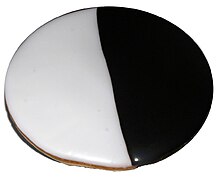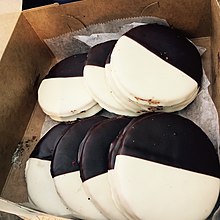 | |
| Alternative names | Half-and-half cookie |
|---|---|
| Type | Cookie |
| Course | Snack or dessert |
Black-and-white cookies, half-and-half cookies, and half-moon cookies are similar round cookies iced or frosted in two colors, with one half vanilla and the other chocolate. They are found in the Northeastern United States and Florida. Black-and-white cookies are flat, have fondant or sometimes royal icing on a dense cake base, and are common in the New York metropolitan area. [1] Half-moon cookies are slightly dome-shaped (convex), have frosting on a fluffy angel cake base, and are common in Central New York and Boston, Massachusetts. [2] [3] [4]
The Amerikaner is a similar cookie in German baking.
History
Designs with contrasting light and dark parts were popular at the turn of the 19th century, including on baked goods and desserts. Cookies with cake bases also became popular at the time. Culinary historian Stephen Schmidt sees black-and-whites and half-moons as straightforward convergences of the two trends, and compares them to teacakes served in the Southern United States. [1]
Black-and-white cookies

The black-and-white cookie is commonly traced to Glaser's Bake Shop in the Yorkville neighborhood of Manhattan, founded in 1902 by Bavarian immigrants. [note 1] The black-and-white cookie was among the original recipes used by Glaser's Bake Shop. [5]
By the post-war period, black-and-white cookies had become part of American Ashkenazi Jewish culinary repertoire, deeply rooted in the Jewish communities of New York City and elsewhere around the United States. [6] [7] The cookies are a fixture at many Metro New York Jewish bakeries, including Moishe's Bake Shop [1] and William Greenberg's Desserts. [6]
In Italian-American bakeries in New York City, a thin layer of apricot jam is sometimes present below the fondant. [1]
Half-moon cookies

Half-moon cookies can be traced to Hemstrought's Bakery in Utica, New York, who started baking half-moons around 1925. [note 2] [8] [9] Half moons are still very popular in Utica, [10] and local media often debates which bakery makes the best half-moons. [11] [12]
Half-moons are often frosted higher on one side than the other. In Boston, sometimes the domed side is frosted rather than the flat side. [13]
Amerikaners
The Amerikaner is often decorated like the black and white cookie, but can be frosted entirely in vanilla instead. [14] The origin and name of Amerikaner in Germany is unclear, as is their possible relationship to black-and-white cookies. It is sometimes claimed that the cookie was introduced or reintroduced by American GIs serving at US military bases in Germany during the 1950s. [14] Another theory proposes a corruption of the word Ammoniumhydrogencarbonat ( ammonium bicarbonate, a leavening agent). [15] In the former East Germany, due to anti-Americanism, the name Ammonplätzchen (Ammonia cookies) was used. [16]
As a racial metaphor
In the 1994 Seinfeld episode " The Dinner Party", Jerry eats a black-and-white cookie while waiting in a New York City bakery with Elaine. He uses the cookie as a metaphor for racial harmony, saying the chocolate and vanilla represent black and white people living together. If the colors mix together well on a cookie, Jerry argues, so can different races in society, suggesting the answer to poor race relations is to "Look to the cookie!" [17] While campaigning in the 2008 United States presidential election at a deli in Hollywood, Florida, Barack Obama bought two black-and-white cookies and said about them, "it's a unity cookie." [18] [19] In a 2015 op-ed in Tablet magazine, African-American Rabbi Shais Rishon argued that the cookie, with its cleanly separated black and white sides, better represented racial segregation. [20]
See also
- Cuisine of New York City
- List of shortbread biscuits and cookies
- Neenish tart
- Roze koek
- Utica, New York § Culture
Notes
- ^ Not to be confused with the village of Yorkville near Utica in Central New York.
- ^ Hemstrought's began business in 1920, but does not appear to have baked half-moon cookies before 1925.
References
- ^ a b c d Spataro, Joanne. "The Real History of Black and White Cookies". VICE. Vice Media Group. Retrieved November 19, 2021.
- ^ Sietsema, Robert (May 19, 2015). "New York in a Dozen Dishes". Houghton Mifflin Harcourt. pp. 279–290. ISBN 9780544453630.
- ^ "The History of the Half Moon / Black and White Cookie". Driving Inertia. February 19, 2013. Retrieved July 12, 2021.
- ^ "Halfmoon Cookies". Saveur. October 13, 2000. Retrieved July 12, 2021.
- ^ Sietsema, Robert (June 2, 2014). "The Black-and-White Cookie's Curious History". Eater NY.
- ^ a b Salzhauer, Rebecca (August 18, 2021). "An ode to the black and white cookie". The Forward. The Forward Association, Inc. Retrieved November 19, 2021.
- ^ Clark, Melissa. "Black-and-White Cookies". 100 Most Jewish Foods. Tablet Magazine. Retrieved November 19, 2021.
- ^ D'imperio, Chuck (April 14, 2015). A Taste of Upstate New York: The People and the Stories Behind 40 Food Favorites. Syracuse University Press. pp. 69–72. ISBN 9780815653233.
- ^ "Utica Bakery Home to the Original Halfmoon Cookies Celebrates 100 Years". spectrumlocalnews.com. Retrieved July 12, 2021.
- ^ "Half Moon Cookies Make Their Mark in Utica". spectrumlocalnews.com. Retrieved January 10, 2022.
- ^ Jacob Pucci (April 6, 2018). "CNY's best half-moon cookies: And the winners are..." syracuse. Retrieved January 10, 2022.
- ^ Alana LaFlore. "Half Moon Cookies Make Their Mark in Utica". spectrumlocalnews.com. Retrieved January 10, 2022.
- ^ Kyle Grace Mills (December 4, 2015). "The 11 Best Cookies in Boston". Boston Magazine. Archived from the original on March 4, 2020. Retrieved January 14, 2022.
- ^ a b Khushbu Shah. "WW2 Black and White Cookie". thrillist.com. Retrieved September 1, 2017.
- ^ Honnen, Peter (2008). Alles Kokolores? Wörter und Wortgeschichten aus dem Rheinland. Cologne: Greven Verlag. p. 10. ISBN 978-3-7743-0418-5.
- ^ Martin, Ahrends (1986). Trabbi, Telespargel und Tränenpavillon. Das Wörterbuch der DDR-Sprache. Munich: Heyne. p. 18. ISBN 978-3-4530-2357-4..
- ^ Roberts, Sam (2016). A History of New York in 101 Objects. Simon and Schuster. p. 137. ISBN 9781476728797.
- ^ Clark, Lesley (October 21, 2008). "Barack Obama and the black and white cookie". The Miami Herald. Retrieved May 30, 2013.
- ^ Johnson, Sasha (October 21, 2008). "Obama: McCain is 'running out of time' and 'making stuff up'". CNN. Retrieved May 30, 2013.
- ^ MaNishtana (November 11, 2015). "Black and White and Not All Right: These Cookies Must Stop!". Tablet Magazine. Retrieved November 23, 2021.
- Ashkenazi Jewish culture in New York City
- Ashkenazi Jewish cuisine
- Chocolate desserts
- Cuisine of New York City
- Cuisine of the Mid-Atlantic states
- German-American cuisine
- German-American culture in New York City
- Jewish American cuisine
- Jewish cookies
- Shortbread
- Utica, New York
- Yorkville, Manhattan
- American cookies